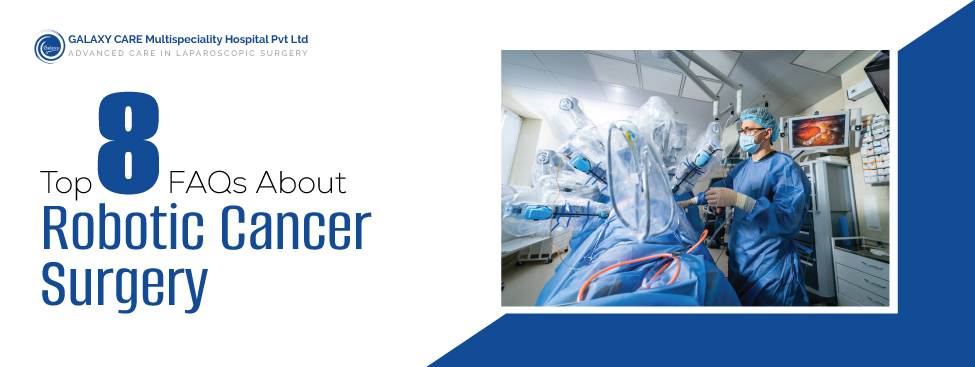
Top 8 FAQs About Robotic Cancer Surgery
Over the past 20 years, robotic cancer surgery has become one of the biggest breakthroughs in cancer treatment. But for many patients and their families, it also brings a lot of questions—What exactly is robotic surgery? How is it different from regular surgery? What does it mean for recovery and long-term results?
At Galaxy Care Hospital, the leading center for robotic cancer surgery in Pune, we understand the concerns patients and families often have. That’s why we’ve created this easy-to-follow guide answering the eight most common questions about robotic cancer surgery to help you feel informed and confident about your care decisions. Let’s begin.
1. What is Robotic Cancer Surgery and How Does It Work?
Robotic cancer surgery is a type of minimally invasive surgery in which surgeons use a sophisticated robotic system to perform complex procedures with enhanced precision, flexibility, and control. Contrary to what some might imagine, these surgeries are not performed by robots alone; instead, the robotic arms acts as an advanced tool controlled entirely by highly trained surgeons.
Using tiny incisions, the surgical team inserts robotic arms equipped with miniaturized instruments and a high-definition 3D camera into the patient’s body. The surgeon sits at a console, viewing the operative field in magnified detail, and operates the robotic instruments with hand and foot controls. The robotic system translates the surgeon’s hand movements into micro-movements, offering a level of accuracy challenging to achieve with the human hand alone.
2. Which Cancers Can Be Treated with Robotic Surgery?
Robotic cancer surgery can be applied to treat various types of cancers, particularly those located in hard-to-reach or delicate areas. Common cancers where robotic surgery is frequently used include:
- Prostate cancer
- Kidney cancer
- Gynecological cancers (uterine, cervical)
- Colorectal cancer
- Some lung and head & neck cancers
The suitability of robotic surgery depends on multiple factors, such as cancer stage, location, and the patient’s overall health. At Galaxy Care Hospital, a multidisciplinary cancer team evaluates each case individually to determine if robotic surgery is the best approach for your specific condition.
3. How Safe is Robotic Cancer Surgery?
Safety is a paramount concern for both patients and healthcare teams. Robotic cancer surgery is considered very safe when performed by experienced surgeons in well-equipped centers like Galaxy Care Hospital. The procedure benefits from the system’s enhanced dexterity and precision, helping to minimize accidental injury to surrounding healthy tissues. Like any surgical procedure, there are risks involved, such as bleeding, infection, or related complications, but multiple studies and extensive clinical experience have demonstrated that robotic surgery’s safety profile is comparable, if not superior, to open or laparoscopic surgery in many cases.
4. How is Robotic Surgery Different from Traditional or Laparoscopic Surgery?
Traditional open surgery involves making large incisions to access the tumor, which can lead to more pain, longer recovery times, and higher complication rates. Laparoscopic or “keyhole” surgery uses small incisions and specialized instruments but is limited by a two-dimensional view and less flexibility of movement.
Robotic cancer surgery takes minimally invasive surgery a step further:
- Enhanced 3D visualization: Surgeons see the area in high-definition, three-dimensional detail.
- Greater dexterity: Robotic arms offer a range of motion beyond human capability, allowing delicate manoeuvres in confined spaces.
- Stability: Robotic instruments eliminate even the smallest unintentional tremors.
These advances contribute to improved surgical accuracy and often better outcomes for patients.
5. What Are the Benefits for Patients?
Patients who undergo robotic cancer surgery often experience several important benefits:
- Smaller incisions: Reduced trauma to healthy tissue translates to less post-operative pain and minimal scarring.
- Faster recovery: Many patients are able to return to daily activities sooner than after traditional surgery.
- Shorter hospital stays: Early mobilization and faster healing may reduce length of hospital admission.
- Lower risk of complications: The precision of robotic instruments can decrease the likelihood of bleeding, infection, and other complications.
- Better functional outcomes: In some cases, such as prostate or gynecological cancers, robotic surgery has been shown to preserve functions like continence or sexual health more effectively.
6. What Are the Risks or Limitations of Robotic Surgery?
While robotic cancer surgery offers many advantages, it is important to understand its limitations:
- Not suitable for all cases: Some complex cancers or patients with advanced disease may still require laparoscopic surgery or open surgery.
- Learning curve: Effective robotic surgery requires specific training and expertise. Choosing an established center with a skilled surgical team is essential.
- Potential complications: Risks such as infection, bleeding, or injury to nearby organs, though generally lower, are still present.
Open and honest discussions between patients and their onco surgeons remain essential in choosing the right treatment option.
7. What Is the Recovery After Robotic Cancer Surgery Like?
Recovery after robotic cancer surgery is often easier and quicker compared to traditional approaches. Because the procedure uses smaller incisions, patients typically experience:
- Less pain and discomfort postoperatively
- Lower need for strong pain medications
- Earlier return to eating, moving, and normal activities
Most patients can expect to be discharged from hospital within a few days, resuming light activities at home shortly thereafter. Individual recovery times will vary based on the specific surgery, cancer type, and overall health. At Galaxy Care Hospital, the patient care team provides tailored support and follow-up to ensure optimal recovery at every stage.
8. Is Robotic Cancer Surgery Expensive?
The use of advanced robotic systems and the need for specialized surgical training means that robotic cancer surgery can be more expensive upfront compared to traditional or laparoscopic procedures. However, this must be balanced against the potential savings from shorter hospital stays, earlier return to work, and fewer complications or re-operations.
Many patients and families find that the benefits, such as less pain, quicker healing, and better functional outcomes, justify the cost. Some insurance policies also cover part or all of the procedure.
Choose Galaxy Care Hospital for Robotic Cancer Surgery in Pune
Robotic cancer surgery represents the forefront of modern surgical oncology, offering hope, precision, and minimized trauma to patients facing a cancer diagnosis. At Galaxy Care Hospital, Pune, we are proud to be recognized as a leading center for robotic cancer surgery in western and southern India, housing the region’s first dedicated robotic theatre.
Our pioneering technology, combined with a highly skilled and compassionate surgical team, enables us to deliver the best possible outcomes to our patients. Every treatment plan at Galaxy Care Hospital is patient-centered, ensuring each person receives personalized care in a modern, supportive environment.
If you or your loved one has been diagnosed with cancer and is considering surgical options, consult cancer surgeons and robotic surgery experts at Galaxy Care Hospital. Take the first step toward expert care and a healthier future. We stand strong with you in your fight against cancer.


